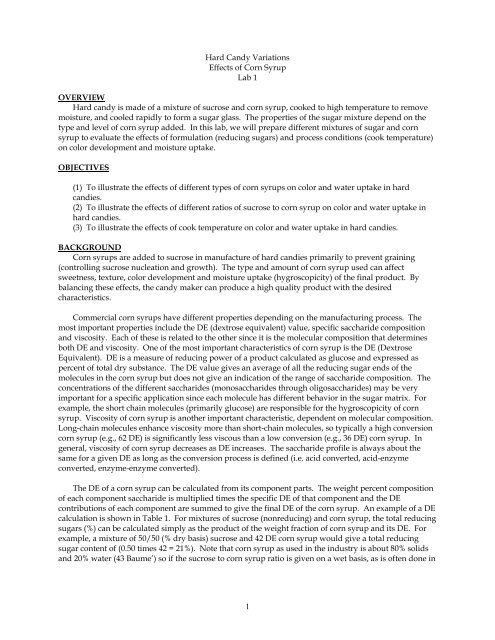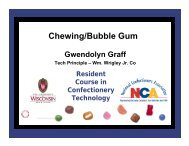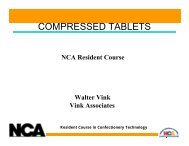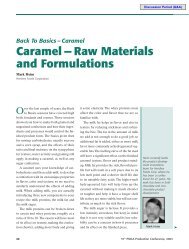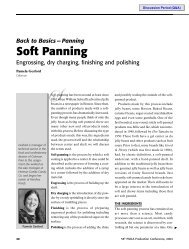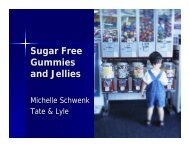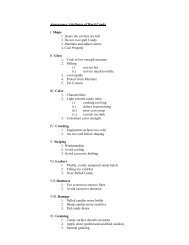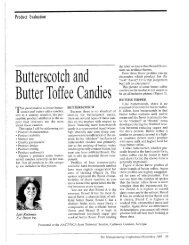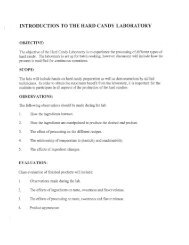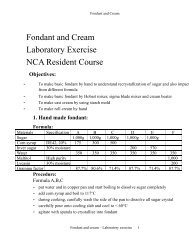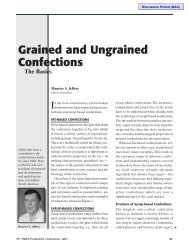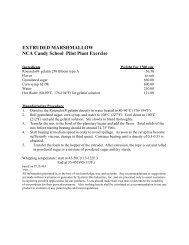Effect of DE of Corn Syrup - staging.files.cms.plus.com
Effect of DE of Corn Syrup - staging.files.cms.plus.com
Effect of DE of Corn Syrup - staging.files.cms.plus.com
Create successful ePaper yourself
Turn your PDF publications into a flip-book with our unique Google optimized e-Paper software.
Hard Candy Variations<br />
<strong>Effect</strong>s <strong>of</strong> <strong>Corn</strong> <strong>Syrup</strong><br />
Lab 1<br />
OVERVIEW<br />
Hard candy is made <strong>of</strong> a mixture <strong>of</strong> sucrose and corn syrup, cooked to high temperature to remove<br />
moisture, and cooled rapidly to form a sugar glass. The properties <strong>of</strong> the sugar mixture depend on the<br />
type and level <strong>of</strong> corn syrup added. In this lab, we will prepare different mixtures <strong>of</strong> sugar and corn<br />
syrup to evaluate the effects <strong>of</strong> formulation (reducing sugars) and process conditions (cook temperature)<br />
on color development and moisture uptake.<br />
OBJECTIVES<br />
(1) To illustrate the effects <strong>of</strong> different types <strong>of</strong> corn syrups on color and water uptake in hard<br />
candies.<br />
(2) To illustrate the effects <strong>of</strong> different ratios <strong>of</strong> sucrose to corn syrup on color and water uptake in<br />
hard candies.<br />
(3) To illustrate the effects <strong>of</strong> cook temperature on color and water uptake in hard candies.<br />
BACKGROUND<br />
<strong>Corn</strong> syrups are added to sucrose in manufacture <strong>of</strong> hard candies primarily to prevent graining<br />
(controlling sucrose nucleation and growth). The type and amount <strong>of</strong> corn syrup used can affect<br />
sweetness, texture, color development and moisture uptake (hygroscopicity) <strong>of</strong> the final product. By<br />
balancing these effects, the candy maker can produce a high quality product with the desired<br />
characteristics.<br />
Commercial corn syrups have different properties depending on the manufacturing process. The<br />
most important properties include the <strong>DE</strong> (dextrose equivalent) value, specific saccharide <strong>com</strong>position<br />
and viscosity. Each <strong>of</strong> these is related to the other since it is the molecular <strong>com</strong>position that determines<br />
both <strong>DE</strong> and viscosity. One <strong>of</strong> the most important characteristics <strong>of</strong> corn syrup is the <strong>DE</strong> (Dextrose<br />
Equivalent). <strong>DE</strong> is a measure <strong>of</strong> reducing power <strong>of</strong> a product calculated as glucose and expressed as<br />
percent <strong>of</strong> total dry substance. The <strong>DE</strong> value gives an average <strong>of</strong> all the reducing sugar ends <strong>of</strong> the<br />
molecules in the corn syrup but does not give an indication <strong>of</strong> the range <strong>of</strong> saccharide <strong>com</strong>position. The<br />
concentrations <strong>of</strong> the different saccharides (monosaccharides through oligosaccharides) may be very<br />
important for a specific application since each molecule has different behavior in the sugar matrix. For<br />
example, the short chain molecules (primarily glucose) are responsible for the hygroscopicity <strong>of</strong> corn<br />
syrup. Viscosity <strong>of</strong> corn syrup is another important characteristic, dependent on molecular <strong>com</strong>position.<br />
Long-chain molecules enhance viscosity more than short-chain molecules, so typically a high conversion<br />
corn syrup (e.g., 62 <strong>DE</strong>) is significantly less viscous than a low conversion (e.g., 36 <strong>DE</strong>) corn syrup. In<br />
general, viscosity <strong>of</strong> corn syrup decreases as <strong>DE</strong> increases. The saccharide pr<strong>of</strong>ile is always about the<br />
same for a given <strong>DE</strong> as long as the conversion process is defined (i.e. acid converted, acid-enzyme<br />
converted, enzyme-enzyme converted).<br />
The <strong>DE</strong> <strong>of</strong> a corn syrup can be calculated from its <strong>com</strong>ponent parts. The weight percent <strong>com</strong>position<br />
<strong>of</strong> each <strong>com</strong>ponent saccharide is multiplied times the specific <strong>DE</strong> <strong>of</strong> that <strong>com</strong>ponent and the <strong>DE</strong><br />
contributions <strong>of</strong> each <strong>com</strong>ponent are summed to give the final <strong>DE</strong> <strong>of</strong> the corn syrup. An example <strong>of</strong> a <strong>DE</strong><br />
calculation is shown in Table 1. For mixtures <strong>of</strong> sucrose (nonreducing) and corn syrup, the total reducing<br />
sugars (%) can be calculated simply as the product <strong>of</strong> the weight fraction <strong>of</strong> corn syrup and its <strong>DE</strong>. For<br />
example, a mixture <strong>of</strong> 50/50 (% dry basis) sucrose and 42 <strong>DE</strong> corn syrup would give a total reducing<br />
sugar content <strong>of</strong> (0.50 times 42 = 21%). Note that corn syrup as used in the industry is about 80% solids<br />
and 20% water (43 Baume’) so if the sucrose to corn syrup ratio is given on a wet basis, as is <strong>of</strong>ten done in<br />
1
industry, then the dry solids percentages must be calculated before the percentage <strong>of</strong> reducing sugars can<br />
be found.<br />
Total reducing sugars in a hard candy affects color, equilibrium relative humidity (ERH), sweetness<br />
and shelf life. Reducing sugar content depends on the type <strong>of</strong> corn syrup used and the level <strong>of</strong> corn<br />
syrup in the formulation. However, inversion <strong>of</strong> sucrose into glucose and fructose during cooking<br />
(temperature, time and pH dependent) can cause a significant increase in reducing sugar content in a<br />
hard candy. That is, inversion occurs more rapidly at higher temperatures and low pH, so the longer an<br />
acidified candy is held at high temperature, the less sucrose (and more glucose and fructose) will be<br />
present in the final candy.<br />
Definitions<br />
<strong>Corn</strong> starch polymeric molecules <strong>of</strong> glucose found in corn<br />
<strong>Corn</strong> syrup a sweetener made by hydrolysis <strong>of</strong> corn starch (sometimes called glucose syrup)<br />
Baume' scale for hydrometer readings (measures specific gravity or density)<br />
<strong>DE</strong> Dextrose Equivalent: measure <strong>of</strong> reducing power<br />
ERH Equilibrium Relative Humidity: the RH <strong>of</strong> air at which a product neither picks<br />
up or loses moisture<br />
Hygroscopicity Capacity <strong>of</strong> a material to pick up moisture from surrounding air<br />
APPARATUS<br />
Copper cooking kettles or electric skillets<br />
Gas burner<br />
Stirring spoon<br />
8 oz. glass jars<br />
Aluminum pans for weighing<br />
Balance<br />
PROCEDURES<br />
The 27 formulations shown on the attached Table 2 have been pre-weighed for you in the copper<br />
kettles (or electric skillets). In addition to the sweeteners, approximately one part <strong>of</strong> water per two parts <strong>of</strong> dry<br />
sugar is added in order to dissolve the sugar. All batches have the same total weight so that cooking times<br />
should be constant, but record the time from when your batch starts to boil to when it reaches the<br />
desired temperature.<br />
Stir the formula slowly as it heats. When the sugar is <strong>com</strong>pletely dissolved, it is no longer necessary<br />
to stir. Keep the flame (or electric setting) rather low when temperature is between 230 and 250°F<br />
because there will be moderate foaming. After foaming has subsided, the gas fire (or electric setting) can<br />
be increased slightly. However, we want to keep the cooking rate as constant as possible for all cooks so<br />
that the cooking times are constant and are not a factor in color <strong>com</strong>parisons.<br />
Shut the flame <strong>of</strong>f at the required final temperature and quickly fill the two metal weigh boats about<br />
half full by using the wooden spoon. Be careful to control the amount <strong>of</strong> syrup in each weigh boat. Then<br />
carry the kettle to the cooling table and pour it out. With a knife, score several one-inch squares that will<br />
be used for moisture uptake tests. When the candy is cool, break <strong>of</strong>f enough squares to fill an 8 oz. jar<br />
identified with your code number. Note that the syrup is still losing water while it is held at high<br />
temperature even though the flame is not on and the syrup is not boiling. So be as quick as possible<br />
(while still being safe) once your syrup has reached the desired temperature.<br />
Cautionary note. Sugar syrup at 300°F is extremely hot and therefore, extremely dangerous. If you<br />
get any <strong>of</strong> it on you, it will burn you severely before you get a chance to wash it <strong>of</strong>f. Always use gloves<br />
2
when handling hot surfaces, never touch a hot sugar syrup with your hands and be careful not to allow<br />
the syrup to spill when you carry the kettle to the table. Be very, very careful!<br />
Record the weight <strong>of</strong> one <strong>of</strong> the aluminum weigh boats (use an empty weigh boat to tare the scale).<br />
Place these samples in the oven at elevated temperature and humidity. Tomorrow morning weigh your<br />
sample again (remember to tare the scale again with an empty pan). Calculate the percent moisture<br />
pickup (see below) and report the results in the appropriate column in Table 2. Please let me know if you<br />
can not weigh your sample during this time period and we’ll make other arrangements for you.<br />
Percent moisture pickup can be calculated as follows:<br />
% moisture pickup = {(Wf - Wi)/ Wi}x 100<br />
where Wf is the final weight and Wi is initial weight <strong>of</strong> sample.<br />
The second weigh boat will be used to measure color with the Hunter colorimeter. Each sample will<br />
be placed on the stand and the L,a, b values recorded at three points on the disk. The average <strong>of</strong> the three<br />
readings should be recorded in Table 2. These samples will also be used to measure water content (Karl<br />
Fisher titration) and Tg (differential scanning calorimeter).<br />
You need to calculate the percentage <strong>of</strong> reducing sugars in each formulation. The remainder <strong>of</strong> Table<br />
2 will be filled out in the follow-up class period based on data obtained from each <strong>of</strong> the other students.<br />
DATA ANALYSIS AND DISCUSSION OF RESULTS<br />
Once all the data has been <strong>com</strong>piled, you need to analyze the results. This data set provides<br />
numerous <strong>com</strong>parisons and correlations that demonstrate the principles discussed in class. Some<br />
example <strong>of</strong> analyses/correlations for you to consider include:<br />
1. What factors affect Tg?<br />
2. What factors affect water content?<br />
3. What factors affect color development?<br />
4. What factors affect water sorption?<br />
5. What other connections can you make?<br />
ADDITIONAL QUESTIONS<br />
1. What would be effect <strong>of</strong> using more or less water in the sugar mixture before boiling?<br />
2. If you were to use high fructose corn syrup (basically a 97 <strong>DE</strong> corn syrup in which some <strong>of</strong> the<br />
glucose is enzymatically converted to fructose) to make a hard candy, what would you predict would<br />
happen to color and moisture uptake and why.<br />
3
3. Was your hard candy sticky after the moisture sorption test? What factors do you think affect<br />
stickiness <strong>of</strong> hard candies? Which ones would you predict would be most sticky and which would be<br />
least sticky? Why?<br />
Table 1. Determination <strong>of</strong> dextrose equivalent (<strong>DE</strong>) from corn syrup <strong>com</strong>position. Example provided for<br />
acid-converted 42 <strong>DE</strong> corn syrup as provided by ADM (see corn syrup specification sheets).<br />
Component<br />
Composition 1<br />
(weight %)<br />
4<br />
Observed 2<br />
<strong>DE</strong><br />
Contribution 3<br />
To <strong>DE</strong><br />
Monosaccharides 20 100.0 20.0<br />
Disaccharides 14 58.0 8.12<br />
Trisaccharides 12 39.5 4.74<br />
Tetrasaccharides 9 29.8 2.68<br />
Pentasaccharides 8 24.2 1.94<br />
Hexasaccharides 7 20.8 1.46<br />
Hepta and higher 30 10.2 3.06<br />
Total 100 42.0 4<br />
1 Composition given in specification sheet<br />
2 <strong>DE</strong> <strong>of</strong> pure individual <strong>com</strong>ponent, based on experimental measurement (courtesy <strong>of</strong> ADM)<br />
3 Product <strong>of</strong> <strong>com</strong>position (in weight fraction) times observed <strong>DE</strong> <strong>of</strong> <strong>com</strong>ponent<br />
4 Sum total <strong>of</strong> all contributions to <strong>DE</strong>
Code<br />
Composition<br />
Sucrose/<strong>Corn</strong><br />
<strong>Syrup</strong> (%dry<br />
basis)<br />
Cook<br />
Temperature<br />
(°F)<br />
Cook Time<br />
(min.)<br />
Reducing<br />
Sugars (% dry<br />
basis)<br />
1 70/30 36 <strong>DE</strong> 305 10.8<br />
2 70/30 36 <strong>DE</strong> 305 10.8<br />
3 70/30 36 <strong>DE</strong> 305 10.8<br />
4 70/30 42 <strong>DE</strong> 305 12.6<br />
5 70/30 42 <strong>DE</strong> 305 12.6<br />
6 70/30 42 <strong>DE</strong> 305 12.6<br />
7 70/30 62 <strong>DE</strong> 305 18.6<br />
8 70/30 62 <strong>DE</strong> 305 18.6<br />
9 70/30 62 <strong>DE</strong> 305 18.6<br />
10 70/30 36 <strong>DE</strong> 285 10.8<br />
11 70/30 36 <strong>DE</strong> 285 10.8<br />
12 70/30 42 <strong>DE</strong> 285 12.6<br />
13 70/30 42 <strong>DE</strong> 285 12.6<br />
14 70/30 62 <strong>DE</strong> 285 18.6<br />
15 70/30 62 <strong>DE</strong> 285 18.6<br />
16 70/30 36 <strong>DE</strong>* 285 10.8<br />
17 70/30 36 <strong>DE</strong>* 285 10.8<br />
18 70/30 62 <strong>DE</strong>* 285 18.6<br />
19 70/30 62 <strong>DE</strong>* 285 18.6<br />
20 50/50 42 <strong>DE</strong> 305 21.0<br />
21 50/50 42 <strong>DE</strong> 305 21.0<br />
22 50/50 42 <strong>DE</strong> 305 21.0<br />
23 30/70 42 <strong>DE</strong> 305 29.4<br />
24 30/70 42 <strong>DE</strong> 305 29.4<br />
25 30/70 42 <strong>DE</strong> 305 29.4<br />
26 100 Sucrose 305 0<br />
27 100 Total Invert 289 100<br />
28<br />
100 Maltitol<br />
<strong>Syrup</strong><br />
305<br />
0<br />
* Milk solids added to promote mailard browning<br />
5<br />
Final H2O<br />
(measured %)<br />
Table 2. Hard candy <strong>com</strong>positions and data sheet.<br />
Color Moisture Pickup<br />
(g/100 g<br />
candy)<br />
Texture<br />
<strong>com</strong>ments
RESULTS AND DISCUSSION<br />
The intent <strong>of</strong> this lab was to provide an introduction to the most important aspects <strong>of</strong> sugar<br />
confectionery – the properties <strong>of</strong> sugar syrups. The 27 formulations were designed to provide quite a<br />
range <strong>of</strong> different <strong>com</strong>positions and process conditions to give differences in color development,<br />
moisture content, moisture uptake and glass transition temperature (Tg). Several replicate conditions<br />
were included to note the variability from batch to batch.<br />
From the data collected from the entire class (Table 2 above), numerous connections and<br />
interactions that demonstrate the physico-chemical principles <strong>of</strong> cooking sugar syrups can be made. A<br />
good lab report would fully develop these connections along with an explanation <strong>of</strong> the scientific<br />
principles involved. Places where the data deviate from expected trends should be noted and reasons for<br />
these deviations suggested.<br />
Variability between duplicates:<br />
Comparing first the cook time, not surprisingly there were probably some differences between<br />
the replicate samples. Cook time was a function <strong>of</strong> the gas flame height and since that was not controlled<br />
between groups, it’s not a surprise if the time to reach cook temperature varied between duplicates.<br />
These differences in cook times will have caused differences in the amount <strong>of</strong> sugar hydrolyzed<br />
(inverted) during cooking. Thus, differences in cook time lead to differences in color development. If<br />
cook temperature and cooling time (time from reaching cook temperature to solidification on the table)<br />
were exactly the same in replicate samples, we would expect moisture content to be the same. However,<br />
moisture changes continue to occur as long as the syrup is held at elevated temperatures and since each<br />
person was more or less quick about pouring samples and solidifying the mass, we observe differences in<br />
moisture content. These differences in moisture content lead to differences in Tg and moisture sorption.<br />
Thus, even though these samples were duplicate formulations, the differences in process conditions led<br />
to differences in physical properties. This is an important point to recognize – the end result in your<br />
candy will <strong>of</strong>ten be due to slight deviations in process conditions.<br />
Initial moisture content:<br />
In general, the moisture content <strong>of</strong> the candies after solidification should be related to the boiling<br />
point elevation for that <strong>com</strong>position. At the designated cook temperature, the amount <strong>of</strong> water<br />
remaining is governed by this boiling point elevation. Since boiling point is determined by the number<br />
and molecular weight <strong>of</strong> the sweeteners, those formulations with more and smaller molecules should<br />
have a higher boiling point for a given weight <strong>of</strong> sweetener added. Thus, we would expect that higher<br />
<strong>DE</strong> formulations (more smaller molecules) would have more water remaining, for a given cook<br />
temperature, than lower <strong>DE</strong> formulations (more larger molecules). Also, we would expect that a lower<br />
cook temperature would leave more water remaining, so the formulations cooked to lower temperature<br />
should have higher moisture content.<br />
Another trend we would expect to see is that identical formulations cooked to different<br />
temperatures would have different initial water content.<br />
Furthermore, the formulation with all invert sugar should have the highest water content. This<br />
formulation had the highest level <strong>of</strong> low molecular weight sugars and was cooked only to low<br />
temperature, both factors that led to the high water content.<br />
Color development:<br />
Color in cooked sugar syrups <strong>com</strong>es from a <strong>com</strong>bination <strong>of</strong> Maillard browning, the reaction<br />
between reducing sugars and amine (protein) <strong>com</strong>pounds, and caramelization. Important factors that<br />
affect color development include the amount <strong>of</strong> reducing sugars present, the presence <strong>of</strong> amine<br />
<strong>com</strong>pounds, the cook time and temperature. In general, formulations with high levels <strong>of</strong> reducing sugars<br />
6
that are cooked for a long time at elevated temperatures would be expected to have the brownest color.<br />
Note that corn syrup has very little protein, but does have small amounts <strong>of</strong> amine <strong>com</strong>pounds, which<br />
are sufficient to promote Maillard browning. In these experiments, the brown color is indicated by the L<br />
value obtained from the Hunter colorimeter, with lower L values indicating more brown color.<br />
For a given cook temperature, we would expect the L value to decrease as the amount <strong>of</strong><br />
reducing sugars increased and cook time increased. When there is variability in replicates it is probably<br />
due to the differences in cook time. Formulations cooked to lower temperature would be expected to<br />
have less color.<br />
Glass transition temperature:<br />
The temperature at which the liquid syrup turns into a solid glassy matrix is the glass transition<br />
temperature (Tg), in this case measured by calorimetry. The two main factors that affect Tg are molecular<br />
weight <strong>of</strong> the sugars in the syrup and the final water content. In general, the more smaller molecular<br />
weight materials and the higher the water content, the lower Tg. In this experimental data set, both<br />
average molecular weight and water content varied with the formulations and cook process.<br />
One indicator <strong>of</strong> average molecular weight is the amount <strong>of</strong> reducing sugars present. In general,<br />
the higher the reducing sugar, the more smaller molecules are present and the lower the average<br />
molecular weight. Thus, we would expect a decrease in Tg with an increase in reducing sugars (lower<br />
average molecular weight).<br />
The second factor that affects Tg is water content. There is a decrease in Tg with increasing water<br />
content.<br />
Moisture sorption:<br />
The hygroscopicity, or propensity to pick up moisture from the environment, <strong>of</strong> a sugar glass<br />
depends primarily on the <strong>com</strong>position. It is well known that smaller molecules (like glucose and<br />
fructose) are more hygroscopic than larger molecules, even sucrose and especially the larger glucose<br />
polymers. Thus, we might expect a relationship between moisture sorption and reducing sugar content<br />
<strong>of</strong> our formulations. Moisture sorption may also be a function <strong>of</strong> water content since the ability <strong>of</strong> a glass<br />
to pick up moisture depends on how easily the molecules move around and make room for the water to<br />
penetrate the glassy matrix.<br />
Since Tg depends on both chemical <strong>com</strong>position and water content in much the same way as<br />
moisture sorption, it is interesting to explore the relationship between sorption and Tg. In a general<br />
sense, formulations that lead to lower Tg, either through addition <strong>of</strong> lower molecular weight <strong>com</strong>ponents<br />
or by adding water, result in more rapid moisture sorption.<br />
Other results:<br />
Some <strong>of</strong> the formulations were made in electric skillets instead <strong>of</strong> being heated in the copper<br />
kettles over open flame. Does the source <strong>of</strong> heat have any effect on the results?<br />
One formulation was made with all sucrose. Without the addition <strong>of</strong> corn syrup or invert sugar,<br />
there was nothing to inhibit the crystallization <strong>of</strong> sucrose and this formulation was seen to grain by the<br />
time it was poured onto the table. Another formulation was made with all invert sugar, a system that<br />
will not crystallize but will also not form a glass at room temperature. This system was still an<br />
amorphous fluid upon cooling on the table.<br />
Improvement <strong>of</strong> experiment:<br />
The primary uncontrolled variable in this experiment was the cook time. Some method <strong>of</strong><br />
controlling heating to minimize variations in cooking times would be beneficial for reducing the<br />
7
variability in physical properties. Perhaps cooking all formulations in electric skillets with<br />
predetermined settings would minimize such differences.<br />
8
<strong>Corn</strong> <strong>Syrup</strong> & Sugars in Hard Candy<br />
Hard Candy Lab 1<br />
Discussion<br />
Allan Buck<br />
Archer Daniels Midland Co.<br />
Resident<br />
Course in<br />
Confectionery<br />
Technology
<strong>Effect</strong>s to be Observed<br />
• <strong>Effect</strong> <strong>of</strong> <strong>DE</strong> <strong>of</strong> <strong>Corn</strong> <strong>Syrup</strong><br />
– Color, hygroscopicity, texture, flavor<br />
• <strong>Effect</strong> <strong>of</strong> cook temperature<br />
– Color, hygroscopicity, water content<br />
• <strong>Effect</strong> <strong>of</strong> reducing sugars in formula<br />
– Color, hygroscopicity, texture,<br />
sweetness<br />
Resident Course in Confectionery Technology
Experimental Design<br />
Ingredients Percent<br />
(dry basis)<br />
Sucrose<br />
26 <strong>DE</strong><br />
Sucrose<br />
42 <strong>DE</strong><br />
Sucrose<br />
62 <strong>DE</strong><br />
65%<br />
35%<br />
65%<br />
35%<br />
65%<br />
35%<br />
Cook<br />
Temperature<br />
Reducing<br />
Sugars<br />
305º F 10.0% 3.4%<br />
305º F 14.7% 3.4%<br />
305º F 21.7% 3.4%<br />
Resident Course in Confectionery Technology<br />
Theoretical<br />
Moisture<br />
0.1% Monosodium Glutamate added to each formula
<strong>Effect</strong> <strong>of</strong> <strong>DE</strong> on Hard Candy<br />
Color<br />
26 <strong>DE</strong> 42 <strong>DE</strong> 62 <strong>DE</strong><br />
0.1% 0.1% MSG MSG added added to to enhance enhance color color response<br />
response<br />
Resident Course in Confectionery Technology
25 min<br />
(225°F)<br />
<strong>Effect</strong> <strong>of</strong> Protein on Browning<br />
Sugar, corn syrup and evaporated milk<br />
40 min<br />
(246°F)<br />
50 min<br />
(248°F)<br />
Resident Course in Confectionery Technology<br />
Sugar and corn syrup only<br />
60 min<br />
(250°F)
O<br />
H O H<br />
H O H<br />
H O H<br />
H O H<br />
OH<br />
D-glucose<br />
C<br />
H 3<br />
O<br />
O<br />
CH 3<br />
Caramelization<br />
H H<br />
CH3 O<br />
CHO<br />
2-furfural<br />
O<br />
O<br />
OH<br />
OH<br />
H O H<br />
H O H<br />
H O H<br />
CH 3<br />
OH<br />
H H<br />
CH3 O<br />
HMF<br />
C<br />
H 3<br />
H O<br />
O<br />
H 2<br />
diacetyl pyruvaldehyde acetol<br />
H O<br />
OH<br />
OH<br />
H O<br />
O<br />
lo w p H<br />
H O H<br />
HC H<br />
H O H<br />
H O H<br />
Resident Course in Confectionery Technology<br />
OH<br />
glyceraldehyde<br />
CHO<br />
O<br />
O<br />
OH<br />
3-deoxy-D-glucose<br />
H O<br />
dihydroxyacetone<br />
O<br />
OH
N<br />
H 2<br />
O<br />
H O H<br />
H O<br />
H<br />
H O H<br />
H O H<br />
OH<br />
D - g l u c o s e<br />
NH<br />
O<br />
H O<br />
H<br />
HOC<br />
H O H<br />
H O H<br />
CH 3<br />
O<br />
H<br />
Maillard Browning<br />
R<br />
OH<br />
C<br />
H 3<br />
NH 2<br />
O<br />
OH<br />
amino acid or protein<br />
R<br />
NH<br />
OH<br />
H O<br />
H<br />
H O H<br />
H O H<br />
OH<br />
Am adori Rearrangem ent<br />
O<br />
O<br />
H H<br />
H O H<br />
H O H<br />
OH<br />
3-deoxy-D-glucosone<br />
lo w p H<br />
Browning Pigm ents<br />
2-furfural<br />
+<br />
5 HM F<br />
HOHC<br />
pyruvaldehyde<br />
diacetyl<br />
acetol<br />
Resident Course in Confectionery Technology<br />
RNH<br />
H O H<br />
H O<br />
H<br />
H O H<br />
H O H<br />
OH<br />
D-glucosylamine<br />
R<br />
N<br />
H O H<br />
H O<br />
H<br />
H O H<br />
H O H<br />
OH<br />
O<br />
H 2
Functional Use and Degree <strong>of</strong> Conversion<br />
Function Low <strong>DE</strong> High <strong>DE</strong><br />
Body Agent<br />
Prevent Crystallization<br />
Viscosity<br />
Foam Stabilization<br />
Browning Reaction<br />
Sweetness<br />
Hygroscopicity<br />
Humectancy<br />
Resident Course in Confectionery Technology
Relative Sweetness <strong>of</strong> Nutritive<br />
Sweeteners*<br />
36 <strong>DE</strong> CSU 35-40<br />
42 <strong>DE</strong> CSU 45-50<br />
62 <strong>DE</strong> CSU 60-70<br />
42% HFCS 100<br />
55% HFCS 100-110<br />
Lactose 40<br />
Dextrose 70-80<br />
Fructose 150-170<br />
Sucrose 100<br />
Resident Course in Confectionery Technology<br />
*Handbook <strong>of</strong><br />
Sugars, 1980
Properties <strong>of</strong> Hard Candy as a<br />
Function <strong>of</strong> Sugar/<strong>Corn</strong> <strong>Syrup</strong> Ratio<br />
100% Sucrose 100% <strong>Corn</strong><br />
<strong>Syrup</strong><br />
Super<br />
Highly<br />
saturated<br />
concentrated<br />
Very sweet Low sweetness<br />
High flavor<br />
release<br />
Low<br />
machinability<br />
Low flavor<br />
release<br />
High<br />
machinability<br />
Resident Course in Confectionery Technology


